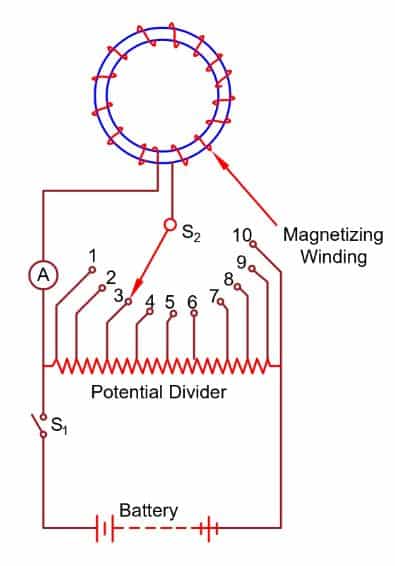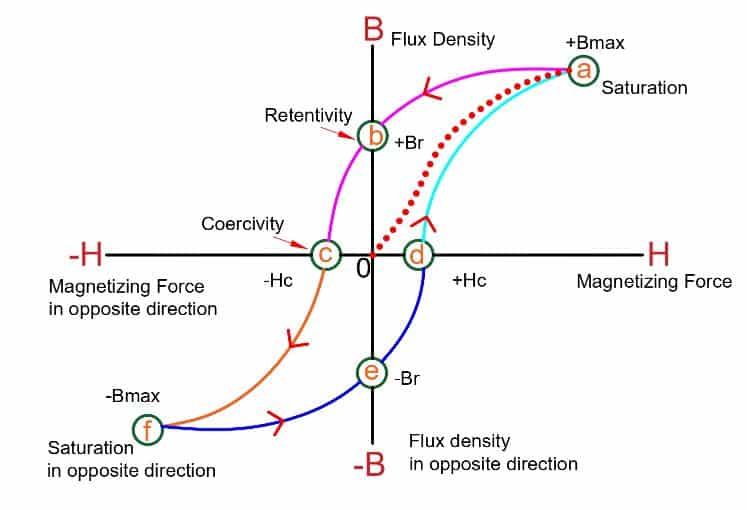A hysteresis loop is a graph in a four-quadrant that shows the relationship between the induced magnetic flux density B and the magnetizing force H. We call this loop curve the B-H loop as well. It is possible to calculate the retentivity, residual magnetism, coercive force, permeability, and reluctance from the hysteresis loop (B-H curve).
On application of an alternating magnetic field to the material, the material magnetizes. The magnetization traces out a loop called a Hysteresis loop. The hysteresis loop is a four-quadrant B-H graph. We can find the Hysteresis loss, retentivity, and coercive force using the hysteresis loop.
Let us take the completely demagnetized ferromagnetic material. The completely demagnetized ferromagnetic material has B=H=0. N number of turns coil is wound on the ferromagnetic material. The coil receives a DC supply. A variable resistance varies the current.

The magnetizing force H is proportional to the current and the number of turns.
H = NI/l
Where,
N = Number of turns of the coil
l = Effective Length of the coil
The magnetic flux density B always lags the magnetizing force H. This property of the magnetic material is known as the hysteresis of a magnetic material.
Important Terms Related to Hysteresis Loop
Coercive Force
Coercivity is a measure of the ability of the ferromagnetic material to remain demagnetized under an external magnetic field. The coercive force is the opposite force that must be applied to the magnetized material to completely demagnetize it. With the application of negative magnetizing force(-H), the residual magnetic flux becomes zero. This negative magnetizing force is equal to the coercive force of the magnetic material.
Residual Flux Density
The magnetic material has a certain value of magnetic flux per unit area when the magnetizing force H is zero.
Retenitivity Flux Density
Retentivity is the ability of the magnetic material to retain a certain amount of magnetic field after removing the magnetizing force after achieving saturation.
What is a Hysteresis Loop?
Definition of Hysteresis
Hysteresis is the property of a magnetic material, and by this virtue, the flux density (B) of this material lags behind the magnetizing force (H).
The hysteresis loop or B-H curve of the magnetic material is given below.

Step 1:
The origin point (o) of the B-H curve is where both the X and Y axis meet. At this point, the current I=0 and magnetic field density B=0.
Step 2:
When we increase the current from zero to a particular value, the magnetizing force(H) and magnetic field(B) are set up. The path followed by the B-H curve is o-a.
Step 3:
The point ‘a’ is called the saturation point on the B-H curve. At this point, if we increase the current further, the magnetic flux density does not increase because all the magnetic poles have already perfectly aligned, and there is no scope for further magnetization of the magnetic material. At point ‘B’, the flux density is maximum(Bm) on the B-H curve. It is the magnetic saturation point.
Step 4:
Now, if we decrease the current, the magnetizing force(H) decreases, and correspondingly, magnetic flux density(B) decreases. However, the B-H curve does not follow the previous path(o-a). It follows the path o-b path.
Step 5:
Point ‘b’ indicates that the H=0, but the magnetic flux density has a positive value. This lagging of B behind H is called hysteresis. Point ‘b’ shows that after removing the current, the magnetic material has a magnetic flux density(B), and its magnitude is equal to ob. The residual flux o-b is due to the retentivity of the magnetic material.
Step 6:
If the direction of the current is reversed, the direction of the magnetizing force is reversed. When the current is increased in the reverse direction, the magnetizing force(-Hc) first brings the residual flux(Br) down to zero, which is called the coercive force.
Step 7:
With an increase in the current in the negative direction, the magnetizing force increases in the negative direction, and the magnetic flux density(B) also increases in the negative direction. The B-H curve follows the path c-f. The magnetic flux density does not increase beyond point f, which is called the saturation point in the reverse direction. At point f, the B and H attain their maximum value in the reverse direction.
Step 8:
With a decrease of the current in the negative direction, the B-H curve follows the f-g path, and the magnetizing force attains zero value when the current is zero. Still, the magnetic material has a residual magnetic flux density(-Br). The o-e is the residual flux in the reverse direction.
Step 9:
If the direction of H is again reversed by reversing the current, the residual magnetism (-Br) reduces to zero at point d following the path g-d. If the current is increased, the B-H curve follows the path d-a. Thus, the path a-b-c-f-g-d-a forms a hysteresis loop.
Importance of Hysteresis Loop
- A small area of the hysteresis loop means less hysteresis loss.
- Residual magnetism, retentivity & coercivity can be calculated with a hysteresis loop.
There is no point “g” in Step 8. I think that is supposed to be point “e”
Thanks for your feedback. I Corrected the same.